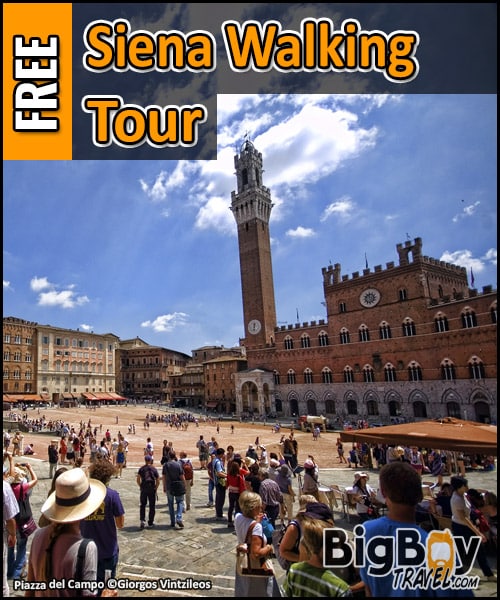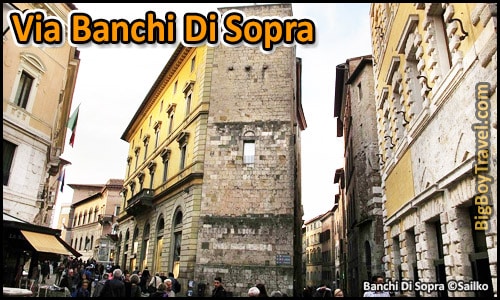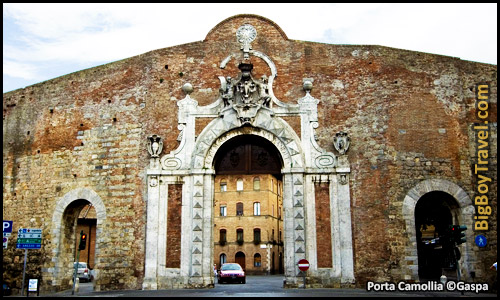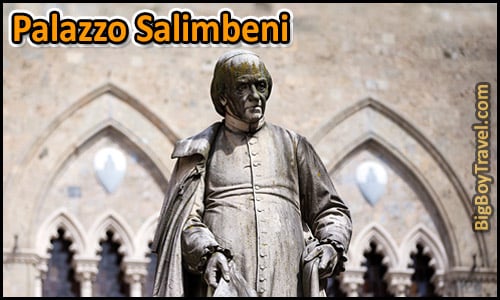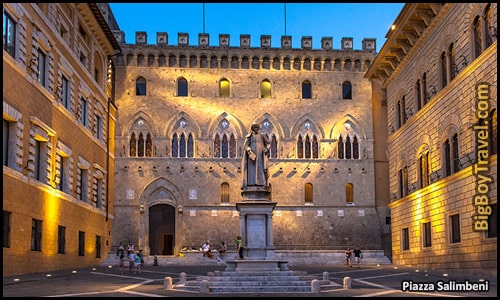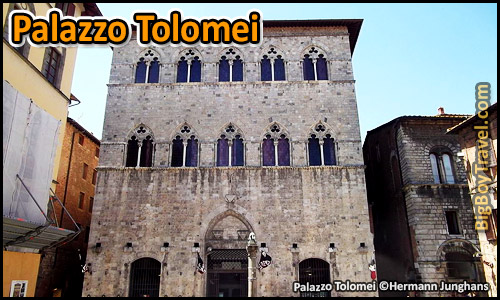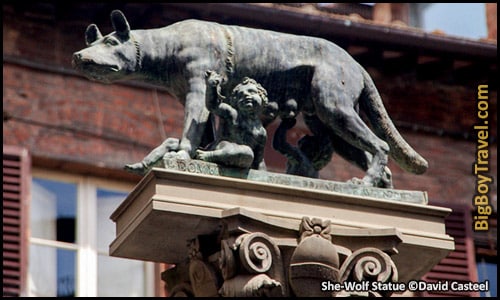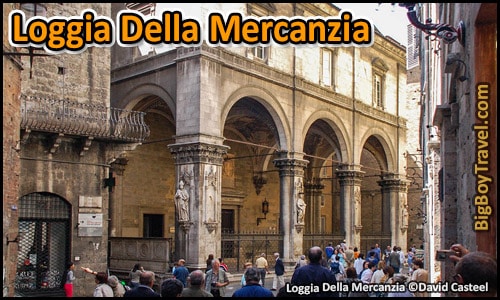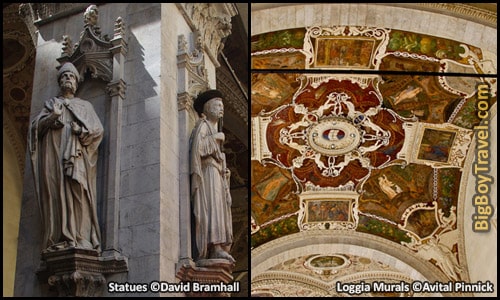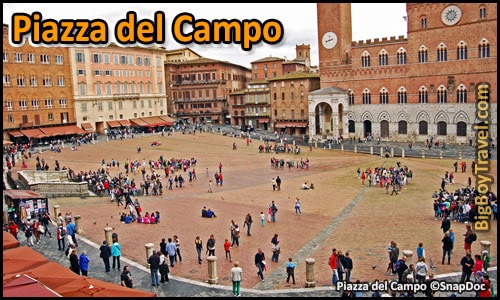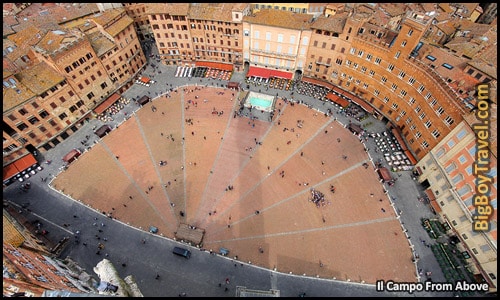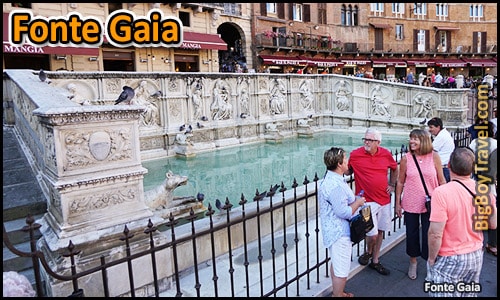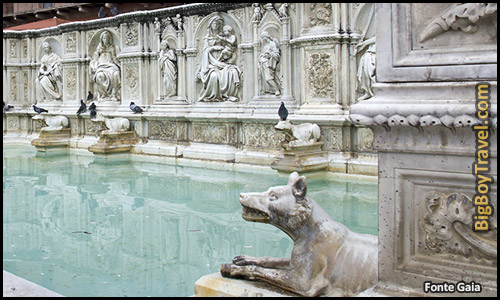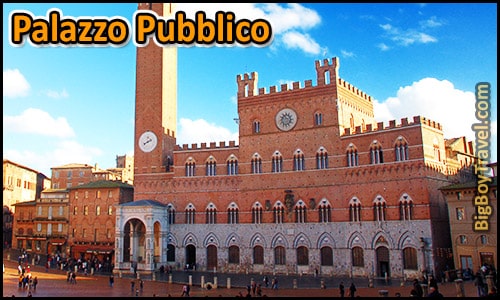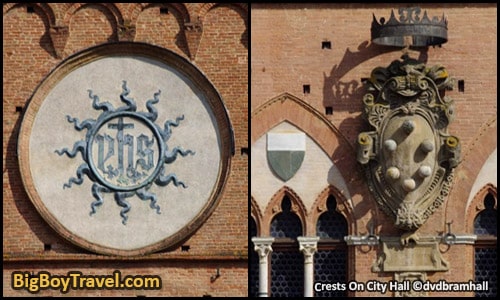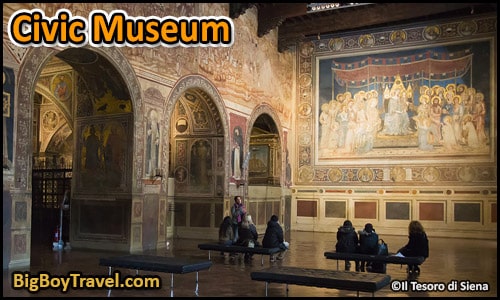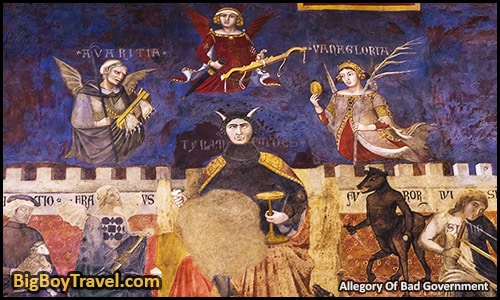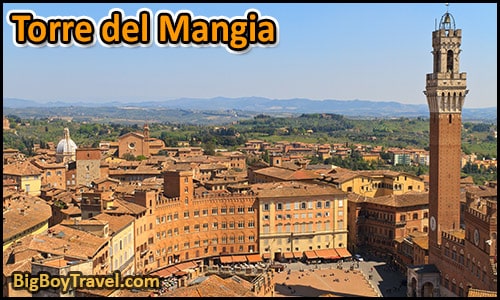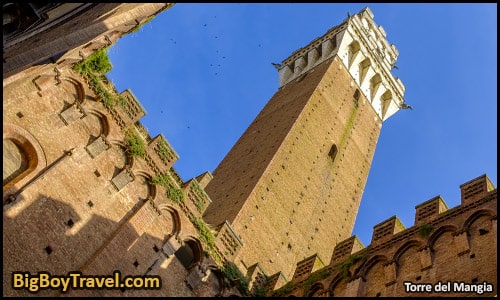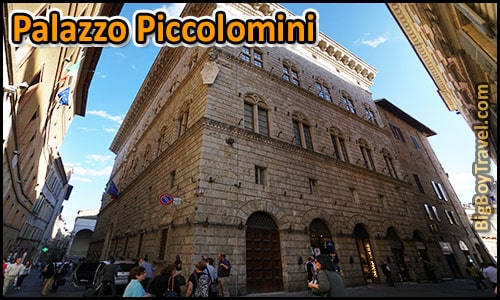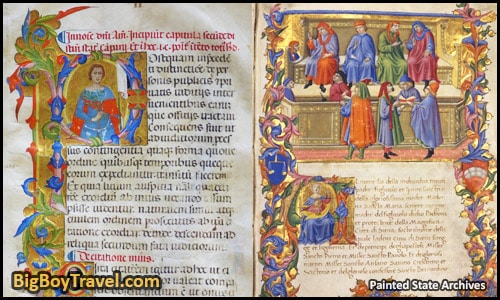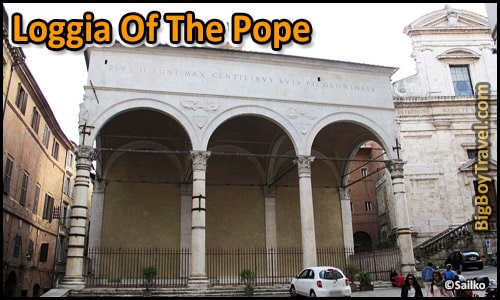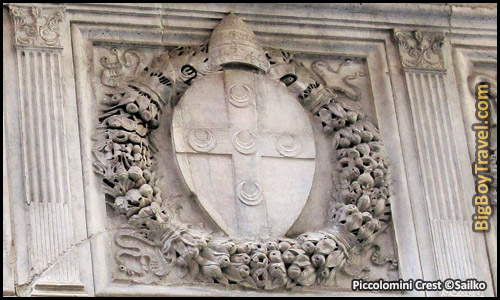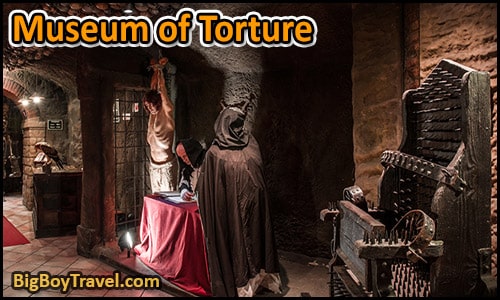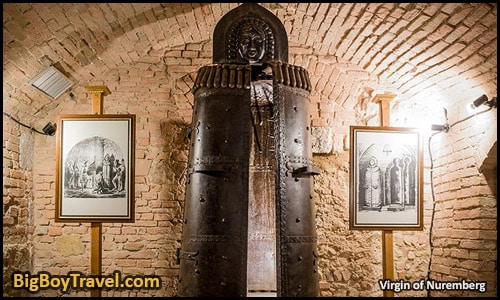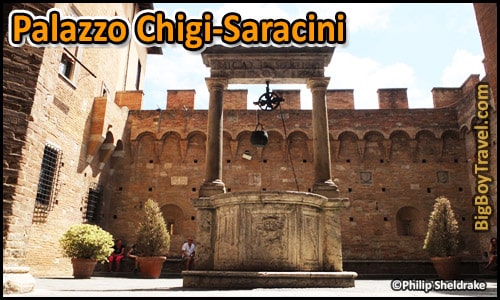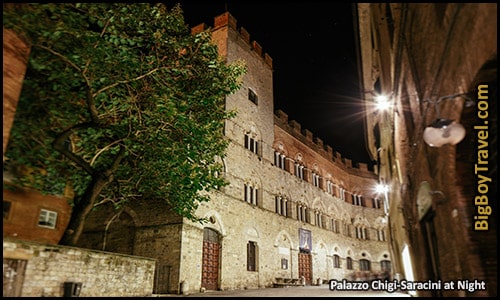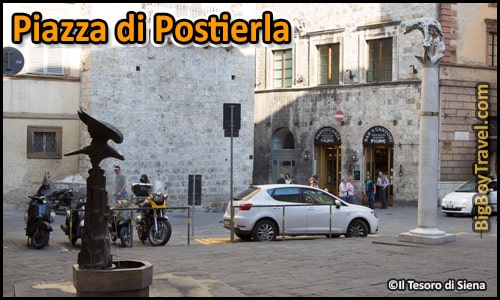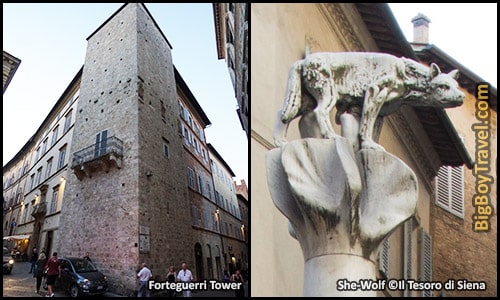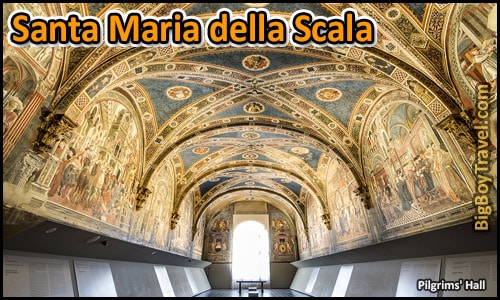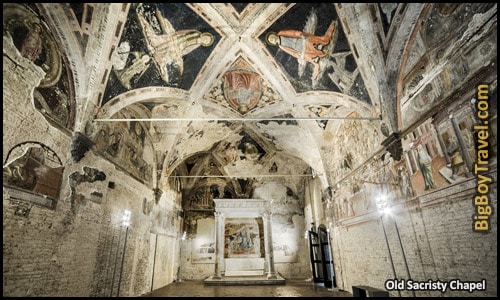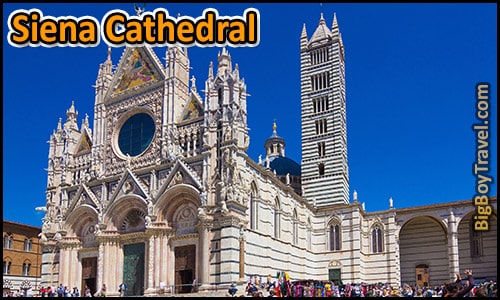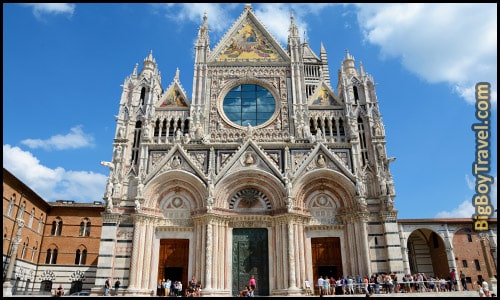Free Siena Walking Tour:
Walking Tour Location: Old Town Siena
Style: Do-It-Yourself Walking Tour (Self Guided)
Start: Via Banchi di Sopra
End: Piazza del Campo
Walking Distance: 1 Mile
Time: 1 Hour for Walk (with attractions 5-6 hours)
Fun Scale: 10 out of 10
Overview of the Old Town Siena:
Our free Siena walking tour covers all of the top sights of the compact Medieval city center. In just a one miles loop you can see the wonderful old town square which doubles as a horse race track called Piazza del Campo, stroll down the main shopping drag Via Banchi Di Sopra, and visit the gorgeous Siena Cathedral.
We hope you enjoy our free Siena walking tour!
1. Via Banchi Di Sopra:
About Via Banchi Di Sopra: Lined with Medieval mansions and fancy shops, the Via Banchi Di Sopra has been a significant street since Siena’s early days. The history of the mighty Banchi Di Sopra is critical to touch on as you start our free Siena walking tour.
By the 600s AD, the main trade route from Northern Europe to Rome (Via Cassia) had become hard to defend along the coast from the Byzantine raiders so ruling the Lombard family decided to move it inland to safer ground. The new route turned away from the Italian coast at Lucca, bypassed Pisa, and went through rural San Gimignano and Siena on its way to Rome. Running right down today’s Via Banchi Di Sopra, this new trade route became part of the famous Via Francigena which helped Siena thrive.
The Via Francigena (meaning “Road from France”) route got an extra boost when it became a pilgrim route in 990 AD thanks to the travels of Archbishop Sigeric of Canterbury. The Archbishop had traveled to the Vatican from Canterbury, England to receive a Pallium honor from Pope John XV then wrote about the 79 stages along the Via Francigena between the inns he stayed in during his 1,056-mile journey home from Rome. Pilgrims following the Archbishop’s route were able to avoid cities held by Siena’s enemies like Florence along the rural trail. Many pilgrims even followed the Via Francigena past Rome and down the Appian Way, where they then continued all the way to Jerusalem by boat.
In addition to pilgrims travelers and increased trade, the Via Francigena also brought a lot of wealth to Siena during the Middle Ages through banking which helped the Sienese people prosper. The exchange of money was vital as the trade route through Siena also crossed paths with the Via Santiago from Spain and the Via Roma from Germany. Siena boomed in the 1200s and quickly became a shortcut for travelers bypassing Venice on the ancient Lime Road connecting the Baltic Sea with Rome. Unfortunately, this Lime Road shortcut also helped the Lombard’s rivals Florence and Bologna grow and eventually overtake Siena.
While it is still Siena’s main shopping lane, Via Banchi di Sopra is also essential for today’s tourists as the road that connects Siena’s city center with both the largest parking area and the central bus station. As you follow the road (called il Corso by locals), expect to see shops selling elegant women’s clothing and fine leather squeezed between noble mansions and historic banks. You may even see a pilgrim or two as 1,200 people a year still complete the full length of the Via Francigena on foot, in addition to the thousands who only hike the sections in Tuscany. On average, the entire 1,056-mile route takes around 100 days on foot or 44 days by biking.
2. Piazza Salimbeni:
About Piazza Salimbeni: The rise of Siena made it a Medieval banking power, which is best realized today in the square Piazza Salimbeni. At the back of the square is the vast Salimbeni Palace (known as Rocca dei Salimbeni), which was built in the 1200s as a giant fortress to house the powerful family and their business operations. Over the centuries, the Salimbeni family served as bankers, collectors, landowners, and became wealthy merchants who had their share of conflicts with other powerful families in town. We will touch on these brutal disputes at the next stop of this free Siena walking tour.
At the peak of the Salimbeni’s wealth in the mid-1200s, the fortified property sprawled out to include living space for their 100-person extended family as well as factories, a warehouse, defensive towers, a cistern, and of course a church. The two massive towers at their mini-castle were the biggest of the over 70 Medieval towers in Siena at the time. The remaining castle features of this gigantic fortified residence can best be seen from the backside, on Piazza dell’Abbadia. A lot of the Salimbenis’ success was fueled by their alignment with the Ghibelline (Holy Roman Emperor supporting) governments who ruled Siena from 1199-1270, a rise in local merchant power, as well as a very bloodthirsty nature against their competitors.
After decades of business struggles, political fights, and bouts of exile, the city of Siena seized the Salimbeni’s fortress-like mansion in 1419 to use as a customs office and salt storage. Banking was later revived on the property when the offices of Siena’s Monte dei Paschi Bank were moved here in 1565. Originally established in 1472, it is considered Europe’s oldest operating bank and is still housed here. In 1866 the bank also bought the neighboring yellow mansion with quioned corners which was built in 1548 over the Salimbeni family’s private chapel. It’s a little ironic that the Monte dei Paschi Bank moved into the mansion as it was initially set up to help protect the citizens against lenders like the Salimbenis.
Further boosting the square’s banking prowess, Ambrogio Spannocchi (former treasurer to Siena’s Pope Puis II), built a sizeable adjacent mansion on the Southside of Piazza Salimbeni in 1473. If you look under the roofline of the Spannocchi Villa, you will see the busts of numerous Roman Emperors as his nod to getting rich working in Rome. While the square is an open public space today, through Medieval times, the Piazza Salimbeni was a large private garden for Spannocchi’s mansion.
In 1882, the walled-off garden was removed to make way for this paved public area complete with a central statue of Sienese scholar Sallustio Bandini. In the early 1700s, Bandini considered an advocate of free trade and a fighter for the removal of feudal tariffs and tolls. This statue placement is ironic as part of the Salimbenis wealth came from their country land holdings and fees collected on bridge crossings. After his death, Bandini donated his enormous private collection of books and manuscripts to the city of Siena.
3. Palazzo Tolomei:
About Palazzo Tolomei: The pale stone Tolomei Palace (Palazzo Tolomei), with its Gothic windows and Medieval embellishments, is one of our favorite exteriors on this free Siena walking tour. Built from 1205-12 by the Tolomei banking family, this timeless mansion is the oldest private residence in Siena. The Tolomeis were fierce rivals in almost every way to the Salimbeni family, from international banking and merchant trade to even which rulers they supported. The Tolomeis were members of the Guelphs party (Pope supporters) like rival Florence, while the Salimbenis were Ghibellines (aligned with the Holy Roman Emperor) who controlled Siena’s government from 1234-1270. It’s fitting that today the lower level of the Tolomei Mansion is home to the local offices of the Bank of Florence, while the Salimbeni Mansion holds the Bank of Siena.
The conflicts between the two dominant noble families often turned violent in the streets, sometimes over petty things like whose family tree was bigger. The Tolomeis claimed roots back to ancient Eygpt (though likely from Germany) while the Salimbenis’ fame went back to the 1st crusade and the battle of Antioch. The feuds between their political parties led to random exiles of each of the families. The political ran even deeper back to the Henry the Lion (Welf or Guelph family & Duke of Bavaria) versus the Conrad King Conrad III of Germany (Hohenstaufen family & Dukes of Swabia, Ghibellines) early as the 1140s.
Fresh off of defeating Florence in 1260 the empowered Ghibellines started tossing Guelphs out of Siena including the Tolomeis. When a mob from the Salvani family (Ghibellines) descended on the Tolomeis in 1267, their fantastic mansion was almost ruined in the attack. It didn’t take long for the exiled Tolomeis to get even. Because there was no crowned Holy Roman Emperor from 1250-1313 after the Hohenstaufens died out, Siena’s Ghibellines alliances grew weak, and the Tolomeis along with the Florence’s Guelph League army struck back.
The two sides met on the battlefield in 1269 where Regolino Tolomei killed Siena’s military leader Provenzan Salvani (the same man who ruined their mansion) sealing the victory for Florence. Regolino Tolomei returned to Siena with Salvani’s head on a lance like a trophy, parading it through town, and marking an end to the Ghibelline government. The Tolomeis even tore down the Salvani’s mansion and towers to use as building supplies to repair their family home. These repairs are still visible in the different colored stone on the top couple floors of Palazzo Tolomei, which has since been preserved like a snapshot into the Middle Ages. It’s fitting that today the lower level of the Tolomei Mansion is home to the local offices of the Bank of Florence, while the Salimbeni Mansion holds the Bank of Siena.
While the new Guelph government (1287-1355) brought Siena more peace and prosperity, the Tolomei and Salimbeni families were still at each other’s necks. Our favorite Tolomei story from 1331 sounds like something straight out of Game of Thrones. After some members of the Salimbeni family tried to start a fire at Palazzo Tolomei, they were invited to a banquet at the Tolomei’s rural farmhouse the very next night where they were poisoned. In total 18 of the Salimbenis died and their countryside home was forever nicknamed Villa Malamerenda, literally meaning Bad Snack or Banquet in Italian.
Palazzo Tolomei is probably most famous as the home of Pia Tolomei who has been the subject of many tragic Italian plays. Pia’s strife started when she was forced into a politically arranged marriage to Nello Pannocchieschi, the Podesta (Chief Magistrate) of Volterra who had just become the Captain of the Guelph League. During the marriage, she was held more as a prisoner than a wife in Nello’s Castel di Pietra in Maremma. The tragedy came to a climax in 1295 when Nello killed Pia by throwing her out his castle window so he could marry his neighbor, the widowed Countess Aldobrandeschi. The story of Pia’s plight was immortalized in author Dante’s epic novel The Divine Comedy. When Dante meets Pia in purgatory during his story, she is quoted saying “Remember me, I am the Pia, Siena made me, and the Maremma did away with me.”
The feuds between the Tolomeis and Salimbenis also gave Dante inspiration for the two quarreling houses from Verona in the Divine Comedy’s, a tale that possibly inspired Williams Shakespeare’s Romeo and Juliet 250 years later. Oddly enough, there is even a fantastic Juliet-style balcony on the Northern side of the Tolomei Mansion right above a plaque in Pia Tolomei’s honor.
The slender statue in front of Palazzo Tolomei will be your first exposure of many wolves around town referencing the mythological founding story of Siena. If you remember folklore, Rome was famously founded by brothers Romulus and Remus, who after being abandoned in the woods as children, were raised by the Capitoline She-wolf (lupa). After Romulus killed his brother, the sons of Remus (Senius and Aschius) stole Rome’s golden she-wolf statue as they fled Rome on their way to found Siena. The black and white horses the boys escaped on were donated by Apollo and Diana and led to the colors in Siena’s coat of arms.
The brick Chapel Saint of Christopher on the opposite side of the square was the Tolomeis’ private chapel and is now the official church for the Little Owl Neighborhood (Contrade Civetta). While the temple-like church was only built in 1800, the family’s chapel originally dates back to the 11th Century and was once the meeting point of the Siena’s Council of Nine government while Palazzo Pubblico was being built. The two statues on the facade of the church depict Saint Bernardo Tolomei, a monk who died fighting the plague of 1348, and Nera Tolomei, who was known for her charity.
4. Loggia Della Mercanzia:
About Loggia Della Mercanzia: In 1125, Siena gained the right to trade as a Free Commune by the Bishop in exchange for helping him fight the city of Arezzo. Soon after local merchants banned together formed a cooperative guild called the Art of Mercantile or Tribunal of the Merchant. While Siena grew, there were bloody power struggles in the city’s early government mainly between the Ghibellines (Holy Roman Emperor supports) and the Guelphs (Papal supports). The Ghibelline ruled Siena with a council of 24 from 1220 to 1270 before the Guelph Council of Nine took over. The merchants guild navigated these changes over time and carved out a very nice role for themselves as they were more loyal to trade than any single ruling body.
Boosts in trade fostered Siena’s prosperity, and the merchants guild got to set up shop right in the center of it all as the city grew. It was at this crossroads where pilgrims from distant trade routes would exchange money and buy goods before either turning to visit Santa Maria della Scala Hospital or continuing through Siena’s old town (Castelvecchio) toward Rome. The Merchant Cooperative grew even more influential in Siena’s politics under the Council of Nine (1287-1355) which operated as a merchant-banking oligarchy. Under this government, the growing city developed a new civic center outside of Siena’s original city walls on land called Il Campo (the field) which was acquired from the Church of San Paolo in 1169. We will visit the rest of the sights on Piazza del Campo in greater depth on our next few stops on this free Siena walking tour.
The Merchant Cooperative got to build a new headquarters called Palazzo della Mercanzia (Merchants’ Palace) on the highest point of Piazza del Campo which was significant. This prime location sat directly across from Palazzo Pubblico (City Hall), was where Northern trade routes entered the new central square, and was the intersection of the main roads from each of Siena’s three hills & neighborhoods. The Merchant Cooperative thrived here as a money exchange house and even had its own police, court, and prison for people who could not pay debts.
In 1417, the rear entrance of the Merchant Cooperative headquarters was expanded with the elegant three-arched loggia you see before you. The statues on the pillars are from the late-1400s and local sculptor Vecchietta did the ones of both Saint Peter and Saint Paul. Before the new loggia, this was the spot where local bankers would set up their benches (banco in Italian) to trade money which gave us the word bank. When a banker would run out of cash, their table would get smashed into a broken bench (bancarotta), known today as bankrupt.
The Merchant Cooperative’s power faded over the centuries, and it sold the building to the United Circle fraternal group in 1739 who restored the loggia and frescos under the canopy.
5. Piazza del Campo:
About Piazza del Campo: All roads in Siena lead to the iconic Piazza del Campo, a vast central square shaped like a large concave clamshell. The square’s name Il Campo (the field) comes from the centuries it was an open field outside of the original Etruscan city center called Castelvecchio. In 1169 the city of Siena bought the land from the nearby Church of San Paolo then started hosting Medieval festivals and markets in the field. Over the next 130 years commerce boomed, and Siena expanded over three hilltops creating the need for a new civic center with Il Campo as the obvious choice. Thanks to careful planning by the city’s Council of Nine government, the wondrous new central Piazza del Campo opened to the public in 1310.
At a whopping 500 feet wide with ten entrances from all directions, Piazza del Campo was a huge public space for Medieval times and is still impressive today. The massive square was considered neutral ground between the three hills of Siena and a space independent of both the ecclesiastical (church) and imperial power. The local government was even okay with large public gatherings in Piazza del Campo which was a freedom that other Medieval rulers would never have allowed. This shared trust was significant as early day Siena had as many 59 neighborhoods called contrade (now 17) and needed a common bond. Run as an oligarchy, much of the city council’s power came by gaining devotion from the citizens through the promise of prosperity.
The aspiration for unified prosperity can be best seen in the hidden meaning of Piazza del Campo’s pavement decorations added from 1327-49. The nine long lines running down the slope of the pavement represent the nine bankers and merchant rulers who claimed their Council of Nine government was in power to make everyone in Siena rich. This symbolism for unity was even more critical as the pavement was finished right after the plague of 1348 wiped out over 1/3 of the population of Siena. The nine lines all meet at a central unified point, and storm drain, in front of the magnificent City Hall (Palazzo Pubblico) which we will visit next on this free Siena walking tour.
As you give a 360-degree glance at the Medieval mansions encircling Piazza del Campo, notice how most of them are relatively equal in height thanks to a new uniformed building code in 1297. At the time, the rest of Siena was littered with over 70 skyscraping tower houses built higher out of both a vain competition of wealth and a need for defense. To the city council, these chaotic towers represented a sign of communal strife while the new buildings with uniformed height would spell unity and prosperity. In comparison, chaotic Bologna had over 180 towers around this time. The city planners wanted to further set Siena apart with a new distinctly Sienese design style with unique mullioned windows divided vertically into two or three parts. This uniformity helped to show the citizens Siena’s power as an independent state from both the Emperor and Pope.
Our favorite of the noble mansions on the square is the Palazzo Sansedoni on the Northern corner of Piazza del Campo. The enormous curved brick mansion was once five separate homes from the 1200s combined in one building with a new facade in the 1760s.
Today the Piazza del Campo is an excellent place have an urban picnic, relax, and people watch. We especially love sitting at one of the outdoor restaurants ringing the square for a laid-back drink just after passeggiata (Italian evening stroll) when the tourist buses are gone. There are cheaper and much better restaurants to visit in Siena, but the atmosphere of Piazza del Campo make its establishments worth a stop. You can also bring your own snack to “picnic” in the square like a local.
If you are looking for a more lively experience, the biggest event in town is the twice a year (July 2nd & August 16th) horse race called Palio di Siena which takes place right in Piazza del Campo. The Medieval Palio (banner) games in Siena go back to the 1200s and once included everything from tournaments for knights, mock battles, live animal hunting, ball games, common man fist fighting, and racing. Bareback horseracing became the main event when it moved into the Il Campo in 1603.
During the Palio, the outer ring of Piazza del Campo gets lined with compacted sand to become the track as over 30,000 fans pack in to see the famous race. Ten of Siena’s 17 contrade (districts) compete by supplying their own jockey, but the horses are chosen by drawing straws. There is a lot of pomp and circumstance surrounding the Palio; however, the race itself is only 90 seconds long. Regardless of when you visit, the atmosphere and timelessness of Piazza del Campo make it our favorite stop on this free walking tour of Siena.
6. Fountain of Joy (Fonte Gaia):
About Fonte Gaia: While Piazza del Campo officially opened in 1310, it took much longer to get the square’s fountain continuously running because of the arid, hilly terrain and lack of nearby water. Through a lot of engineering, they were able to turn Siena’s underground aqueducts into an exceptional 15-mile-long vaulted waterway network below the city known as Bottini. This new civic project not only powered Il Campo’s new fountain but also served as Siena’s primary source of water through 1914. After all that work and engineering, it is no wonder it got the nickname Fountain of Joy (Fonte Gaia) by the happy citizens when it began flowing in 1346. You can tour sections of this ancient underground network on weekdays at Siena’s Water Museum (website).
The Fountain of Joy truly became a work of art when marble sculptures were completed on a sarcophagus-like rectangle base in 1419. Some of the statues took up to nine years to carve and include Mary, Jesus, plus the eight Virtues. We especially love the figure of God bringing life to a reclining Adam which is said to have inspired Michelangelo’s ceiling in the Sistine Chapel. Make a note of the pigeon-covered wolves (lupa) lining the fountain which ties back to Siena’s mythological founding story of Remus’ sons (Senius and Aschius) who fled Rome after their father was murdered.
Copies of the Fountain of Joy’s statues were made to preserve the originals from 1866-69, but with a few changes as all of the nude figures were replaced by ones with added clothes. Luckily the original statues, including the nude ones, can still be seen in the Santa Maria della Scala Museum today.
7. Palazzo Pubblico (Town Hall):
About Palazzo Pubblico: Siena’s fortress-like city hall wasn’t built merely as a center for the local government, as it was indeed a graceful public palace (Palazzo Pubblico). When construction started on the Palazzo Pubblico in 1297, the became a focal point that truly set the tone as the model for a new city building code.
Considered the oldest public building code in Europe the 26 point plan set out not just how the city hall, main square, cathedral, and roads would be laid out, but also established a uniquely Sienese style. A few of these stylistic features stand out as you look at the facade of the Palazzo Pubblico. Not only with the roofline similar in height as the neighboring building, but it lacks balconies on the front and has mullioned windows divided vertically into three parts under elegant Gothic arches. Even the earthy color of the buildings and pavement was unique for the time and became known as burnt Siena.
Before you enter the Palazzo Pubblico, make sure to look at some of the finer details on the facade which curves slightly inward to blend harmoniously with the rest of the square. Notice the steel hoops used for horse parking in the Middle Ages, the seemingly random square holes which were used by the builders to secure wooden scaffolding, and the many black and white colored shields which are crests of Siena. The crests’ colors come from the white and black horses the sons of Remus (Senius and Aschius) rode here from Rome in Siena’s mythological founding story. The story of Romulus and Remus, who were said to have been raised by a wolf, is also the reason for the columned She-wolf (lupe) statue on the right side of the facade.
Sitting high in the center of the hall is the Sun Symbol added here in 1425 by Saint Bernardino to match the famous bronze one on Siena’s Duomo. The Sun Symbol represented the risen Jesus and was meant to be a uniting emblem for Siena’s feuding citizens which had grown more loyal to their neighborhoods (contrade) flags than a common bond. Directly below the Sun Symbol is a large marble coat of arms of the Medici family which was added to the Palazzo Pubblico after Florence took full control of Siena in 1555.
After taking in the beautiful facade of the Palazzo Pubblico, it’s time to dive further into the building’s history by exploring Civic Museum (Museo Civico) housed inside a network of Medieval rooms. The complex’s inner staterooms were vitally important as the nine members of the city council were confined to the building during their two-month-long rotating terms. The isolation of the Council of Nine during their short terms was meant to prevent corruption and outside influence from affecting their decisions. The artwork on the walls and ceilings of the halls reminded the council members of the importance of focusing on their morality and wisdom while applying justice. You can see this artwork up close next on this free Siena walking tour as the cambers are open as a public Civic Museum.
8. Civic Museum (Museo Civico):
About The Civic Museum: A visit to the Civic Museum will start by entering the large open-air inner court and taking in excellent views of the city hall’s soaring bell tower above you. We will talk more about the courtyard and bell tower during the next stop on this free Siena walking tour map. After paying for your admission to the museum, you can dive right in exploring the staterooms and their famous murals painted from 1315 to 1428. Because Siena never truly recovered from the Plague of 1348, they never developed a full slate Renaissance artists like rivals Florence so its collection of masterpieces is much smaller. What it lacks in quantity, Siena’s Civic Museum makes up for with original art that was groundbreaking for the Middle Ages.
The murals in Siena’s City Hall were meant to be secular just like their government (free from religious and imperial influence), which was unique for the time. Before this most artwork in central Europe was commissioned by either the Catholic Church or wealthy aristocrats and was very heavy on biblical influence. If you have ever toured the Uffizi Gallery in Florence and found the repetitive nature of an entire gallery seemingly filled only with slight variations of Virgin Mary and baby Jesus paintings very dull you know what I mean. The paintings in Siena are just bit more full of life, depth, and color for the time compared to similar ones in Florence.
For us, the real joy of touring the Civic Museum comes down to three incredible staterooms starting when you reach the Chapel (La Cappella). Every inch of the evocative space is filled with scenes from the life of the Virgin Mary including the vaulted ceilings, walls, and 22 wooden choir stalls carved from 1415-28 and inlaid with stories of Mary’s life.
Adjacent to the Chapel is Palazzo Pubblico’s largest room known as the Hall of Globes (Sala del Mappamondo). As you enter the hall, you’ll be drawn to a fascinating map of the world painted in the early-1300s, but don’t miss the Maestà (Majesty of Virgin Mary) completed by Simone Martini in 1312. Modeled after an even more famous painting, which we will see later on this free Siena walking tour in the Duomo Cathedral Museum; the Maestà is Palazzo Pubblico’s oldest mural. Mary sits on a throne using her favor to bestow a Republic on Siena that the government must protect. On the opposite wall from Mary’s heavenly glory, a few painted scenes show Siena’s military glory as they had a surge of expansion in the 1300-1400s.
By far our favorite room in the Civic Museum is the unbelievable Hall of Peace (Sala della Pace) which is the perfect embodiment of the spirit of early day Siena. Three astonishing full wall murals in the room (completed by Ambrogio Lorenzetti in 1337) were meant to remind the members of Siena’s Council of Nine to be just in their governance and the dangers of not doing so. The prolific Ambrogio Lorenzetti and his brother Pietro were both students of the Sienese master painter Duccio who we will see more from later on this free Siena walking tour, but first let’s further analyze the Hall of Peace.
The Allegory of Good Government sits on the back wall of Hall of Peace and was meant guide the council members political decisions while ruling. It works from left to right depicting a figure of Justice seated on a throne similar to Mary in the previous room while looking up to Wisdom as she balances both punishments and rewards. The balance of Justice’s scales is checked below by Concordia (harmony with one heart) to ensure that rulings are conducted evenly throughout a procession of all classes of Siena’s society tied by a common bond, which is literally a long rope in the mural. This line of citizens leads to a commanding king-like man on the right meant to be the personification of the Good Commune. The powerful figure sits on a throne flanked on either side by the six good civic virtues (left to right: Peace relaxing on her armor, Fortitude, Prudence, Magnanimity, Temperance, Justice) under three angel-like good theological virtues (Faith, Charity, Hope). The composition of the virtues was meant to show the council members that if they followed them whole heartily, it would lead to the Good Commune.
The huge mural on the room’s side wall ambitiously shows the Effects of Good Government on both Siena and the surrounding countryside. The work is widely considered the largest cityscape painting ever in either Medieval or Renaissance art. Siena’s urban environment is flourishing with bustling shops, packed schools, people dancing in the street, and workers busy building towers. The Effects of Good Government can be seen far into the countryside and nature which was a rare thing to be painted back in those days. The rural Tuscan countryside is peaceful and prosperous illustrated by noblemen setting off from town to hunt and farmers bringing their goods into Siena for the market. All is well, and peace is under the banner of the angel of Security.
On the opposite wall is the Allegory & Effects of Bad Government where a black cloaked Tyranny sits on the throne of the Good Commune. Hovered by Greed, Pride, and Vanity. Instead of the good virtues, Tyranny is flanked by Cruelty, Treason, Fraud, Fury, Diviseness, War as they all sit above sad Justice who has had her hands bound. Looking out onto the city and countryside you can see the horrible effects of a bad government being in control as Siena’s buildings are crumbling, women are being kidnapped, the fields are black, farms are on fire, people are dead in the street. The countryside is under the angel of Terror instead of Security.
Hours: Can climb the tower from 10 am-7pm (4pm in winter). Ticket office closes 45 minutes before the museum closes. Podesta Courtyard is open dawn to dusk, and sometimes later. Cost: Museum only is 9€, or 22€ for a family. A combo ticket for the Civic Museum, Tower, & Santa Maria Scala Museum are 20€ or 40€ for a family. All combo tickets are valid for two days, but combo ticket must first be used at the Tower for some reason. Time Required: While we have hustled through quicker, expect 1 hour with half the time examining the three main rooms. There usually isn’t much of a line but it is more enjoyable early morning and afternoon when you have more space to flow freely enjoy the art.
9. Tower of the Eater (Torre del Mangia):
About Torre del Mangia: Built onto the side of Palazzo Pubblico from 1325 to 1348, the most dominant feature of Siena’s skyline is the iconic brick Tower of the Eater (Torre del Mangia). When the tower was completed, it was the tallest structure in all of Italy at 289 feet (330 feet if you included the lightning rod). The impressive Torre del Mangia is still the 3rd tallest Medieval tower in Italy after the Torrazzo Cremona Cathedral’s Bell Tower (367 ft) and Bologna Asinelli’s Tower (318 ft). The curious nickname Tower of the Eater comes from the first bell ringer (Giovanni di Balduccio) who was said to be lazy, have a big appetite, and therefore was an eater-of-the-profits. A weathered statue of the original bell ringer whom the tower is nicknamed for sits just inside an open courtyard leading to the ticket booth.
The soaring Torre del Mangia was built in a time when Siena was starting to phase out the 70 Medieval towers littering town in favor of a new unified building style. The colossal bell tower was allowed to be an exception to the rule so it could be the same height as the expanding Siena Cathedral to show Church and State were equal in power. While Palazzo Pubblico’s bell tower was finished just before the Plague of 1348 (which devastated much of Europe), the Cathedral’s expansion was crushed by it leaving the State’s tower forever taller.
The marble tabernacle at the base of the Torre del Mangia, called the Chapel of the Square (Cappella di Piazza), was built as an offering to the Virgin Mary as thanks form those who survived the Plague of 1348. Just 100 years before this devastating outbreak of the Black Death, Siena was a thriving metropolis bigger than both Paris and Rome. In total between 1348 and the 1420s, Siena went through 7 plagues, 3 famines, and numerous military attacks which brought the population down from over 70,000 to just 15,000. Unlike Florence, Siena never fully recovered, never had a Renaissance, and remains frozen in the Middles Ages today for our modern tourism enjoyment.
You can climb the Torre del Mangia for excellent views of Il Campo and the compact terracotta rooftops of Siena below. There are no elevators, and it is a strenuous climb up 400 steps in a tight spiral (takes around 15-20 minutes) to reach the top, but it is definitely worth the effort. Keep in mind that the wait to start your climb can be up to a one hour during peak times in the Summer. If the line to climb up is too long, don’t worry as we will be highlighting another tower to get excellent views from later on this free Siena walking tour. Our favorite viewpoint of the Torre del Mangia is looking up at it from the inner courtyard of Palazzo Pubblico which creates a perfect frame and is entirely free to visit.
Hours: Can climb the tower from 10 am-7pm (4pm in winter). Ticket office closes 45 minutes before the tower closes. Podesta Courtyard is open dawn to dusk, and sometimes later. Cost: Tower only is 10€, or 20€ for a family. A combo ticket for the Tower, Civic Museum, & Santa Maria Scala Museum are 20€ or 40€ for a family. All combo tickets are valid for two days, but combo ticket must first be used at the Tower for some reason. Time Required: Since there are only 50 people allowed up at once, on midday in peak season there can be an hour-long wait in line, but we have only seen the queue range from 5-15 minutes in the morning and evening. Expect about an hour for the climb including 15-20 minutes up, a maximum they let you stay on top of 15 minutes, plus 15 minutes back down, and some time to check out the courtyard.
10. Palazzo Piccolomini:
About Palazzo Piccolomini: While this gorgeous Medieval mansion is stunning, its most important feature is the noble Piccolomini family that built it. The family had been rising in power in the 1400s which came to a climax when local Cardinal Enea Piccolomini was elected Pope Pius II in 1458. Enea was considered a brilliant man, who was both an international ambassador and a poet considered one of the most prominent authors of his day. One of his most controversial books was an erotic novel, called the Tale of Two Lovers, but numerous Popes in the 1400-1500s were often known to indulge this side of their humanity. The rise of Pope Pius II was a critical time for the Catholic Church as the Turks had just conquered Constantinople five years before his election and leadership was needed to prevent chaos. Pope Pius II traveled to Ancona in 1464 where he was going to personally lead the Venetian Navy in a battle against the Turkish Sultan, but he died from illness just a day after arriving.
After the Pope Pius II’s death, his large family remained strong mainly thanks to four of his nephews. The boys’ mother had married a Todeschini, but they kept the more famous Piccolomini name instead, and it’s thanks to them that the lineage remained powerful. By 1469, two of the nephews (Andrea & Giacomo) started building the huge family mansion you see today which took 40 years to finish.
The most famous of the Piccolomini nephews was Francesco whom his uncle Pope Pius II had named Cardinal and Archbishop of Siena when he was just 21-years-old. Like his uncle, Francesco was also elected Pope Pius III in 1503 but died only 26 days later from gout. Luckily his brothers lived to broker a couple of Papal power marriages which kept the family name strong. Andrea married the aunt of Pope Paul III, Giacomo married the grandniece of Pope Martin V, and Antonio who was the governor of Castel Sant Angelo in Rome married the daughter of the King of Naples. These strategic marriages led to substantial land holdings and many Duke titles for the Piccolominis before the family name eventually died out around 1680.
The city bought the Piccolomini Palace in the 1800s and it now houses the State Archives, which preserve scrolls and paper material from as early as 736 AD, the city ledgers from the 1200s, and the Museum of the Biccherna Tablets. If you can schedule your visit to see the Biccherna Museum, there are 105 wooden tablets over 500-years-old which were done by some of Siena’s best painters. The Siena Constitution from 1309 is the coolest set of tablets as it was painted in the common or vulgar tongue instead of Latin which made it more accessible to the people.
Archive Hours: Monday, Thursday, and Friday 8am-2pm; Tuesday and Wednesday 8am-5.15pm; Saturday 8am-1.45pm; Sunday Closed. Biccherna Tablet Museum Hours: Three daily guided visits Monday-Saturday 9:30am, 10:30am and 11:30am; Sunday Closed. Cost: Free. Website: Here.
11. Loggia Of The Pope (del Papa):
About Loggia del Papa: As you work your way around the block long Palazzo Piccolomini you’ll find yourself on the Banchi di Sotto which was the lower portion of the main trade route running through Siena. Known as the Via Francigena, this was the most significant Medieval trade route coming from Northen Europe to Rome, and it helped make the Piccolomini family very rich.
As members of the Guelphs party (Pope supporters), the Piccolominis had their political ups and downs but avoided the economic plight of other bankers and merchants in the early 1400s thanks to their substantial land holdings. The family’s wealth helped them gain Count status by the Holy Roman Emperor and also helped Enea Piccolomini get elected Pope Pius II in 1458. This prominence led Pope Pius II to build the Loggia of the Pope in honor of his family in 1462.
The side of the open arcade is covered in crests of Piccolomini family (five crescent moons on a cross), and the Papal tiara even surrounds some of them. You’ll notice the same family crest on other nearby homes the family came own as the Pope’s nephews became Archbishops, Dukes, and one even becoming Pope Pius III in 1503. The neighboring Church of San Martino was the family’s church and has been around since the 1100s (rebuilt in the 1500s with the facade and bell tower later).
12. Museum of Torture:
About Museum of Torture: The Medieval torture museum in Siena isn’t that big, but is pretty cool, especially if you have curious children. It is a pretty tasteful exhibition that doesn’t need to emphasize blood and gore as the instruments speak for themselves. You get a good look with detailed explanations into the horrors of chastity belts, punishment masks, iron maiden sarcophaguses, spiked chairs, plus plenty of vices and clamps used to torture people. While you’ve heard of many of these torture items before, it is very cool to see them in person while gaining a little trivia knowledge along the way.
Hours: Daily 10am-7pm; Only Saturday & Sunday in the Winter. Cost: 10€. Time Required: It’s smaller than you thin and only took us about 30 minutes to get through. If you are pressed for time and still traveling around Tuscany, the same company also has museums in San Gimignano, Lucca, and Volterra. Website: Here.
13. Palazzo Chigi-Saracini:
About Palazzo Chigi-Saracini: The Palazzo Chigi-Saracini is by far the largest and most impressive Medieval mansion on our free Siena walking tour map. Taking up an entire city block, we didn’t even know the mega-mansion was a home the first time we saw it. It really looks like a citadel.
The property got its start in the 1100s as the Palazzo Marescotti of which some Gothic windows and the stone watch tower base remain. You can even see the old Marescotti coat of arms (an eagle with spread wings) on the oldest part of the home which doubled as a government meeting house before City Hall was built. It was from this very bell tower that the joyful song rang out in 1260 as Siena defeated Florence in the Battle of Montaperti.
We love the open-air courtyard as you enter Palazzo Chigi-Saracini which has an ancient water well moved here from a monastery on the outskirts of town. If you choose to tour the mansion’s interior, you will find an art gallery and the furnishings of the preserved aristocratic residence which dates back to 1506. The Piccolomini-Mandoli family expanded the estate, commissioned frieze illustrated stories of Siena’s Pope Pius II, and frescoes of ancient heroines and Bible scenes present in some of the rooms.
In 1770 Bernardino Saracini bought the property and his art collector son expanded the mansion, filled it with even more art, then opened the art gallery to the public in 1806. The palace was eventually handed down to the family’s nephew in Fabio Chigi in 1877 with the condition that he add the Saracini name onto his own. This was a significant compromise since the famous Fabio Chigi he was named after had become Pope Alexander VII in 1655. In 1932, Fabio’s son Count Guido Chigi Saracini founded the Music Accademia and fully opened rest of the home to the public.
Courtyard Hours: Inner Courtyard Monday-Friday 9am-5pm; Saturday & Sunday 10am-5pm. Guided Tours: Inside the mansion and gallery are available in Italian (English in advance) on Monday-Saturday 11:30am; Thursday & Friday second tour at 4pm. Cost: Tour 7€; Inner Courtyard is Free. Website: Here.
14. Square of the Small Door (Piazza di Postierla):
About Piazza Di Postierla: Welcome to the very edge of Siena’s original old town called Castelvecchio. Shaped like a kidney bean, Castelvecchio was where the Roman camp Saena Julia once was before the city developed around it. It is also where mythology says twins Senio and Ascanio (sons of Remus), founded the Siena after their uncle Romulus killed their father.
When the first city walls were built, the Oria Gate into Castelvecchio sat on the Southside of the today’s square (near the Forteguerri Tower) which was nicknamed the small door (postierla). As the city expanded along the hill toward the Duomo, the square became a natural meeting point of all four main roads in early Siena. While the square lost importance as Siena expanded over each of its three hills and developed Il Campo as a new civic center, Piazza Di Postierla has remained an important crossroads. Today many locals still refer to the square as Quattro Cantoni in honor of the four roads that meet here.
The focal point of the square is its central marble column she-wolf statue from the 1400s which is a nod to the myological founding story of Siena. We also like the eagle fountain which is the official well of the Noble Eagle Neighborhood (Nobile Contrada dell’Aquila) and is a common place for baptisms in this part of town. The Chigi family mansion (Palazzo Chigi) behind the eagle fountain has two livings rooms filled with frescoes from 1573 of scenes from the Old Testament.
15. Santa Maria della Scala:
About Santa Maria della Scala: As early as 898 there was already a church, home for the bishop, and the start of a monk run hospital here on the top of Siena’s tallest hill. This ancient hospital was a tremendous asset to Siena which sat on the main trade route from Northern Europe to Rome (called Via Francigena) that offered very little access to healthcare for travelers along its 1,056-mile path. Thanks to Archbishop Sigeric of Canterbury who wrote about his own journey along the trade route in 990, there was a strong influx of pilgrims visitors who started making Siena an extended stay thanks to its hospital.
The church started to build the current hospital complex in 1090, and its buildings provided shelter for pilgrims, assistance to the poor, and an orphanage for abandoned children. The hospital got its name Santa Maria della Scala because it faced the steps (scala) of the church dedicated to the Virgin Mary. While the church ran it for the first 400 years, hospital operations were mainly funded by donations from the city and wealthy noblemen who saw what an asset it was to Siena. Big expansions happened in the 1300s, and the Santa Maria della Scala remained a hospital all the way until 1980 (1920s as an orphanage) before it was converted into the excellent museum. The hospital complex has 7 total levels, but your visit will focus on street level halls and labyrinth of tunnels going 3 levels below ground.
The main street level (4°) of Santa Maria della Scala houses the healthcare reception areas and Medieval chapels filled with frescoes from the 1300s. Most of this level was built right over the old floors of the complex in 1325 as the street level around it had risen over a couple hundred years. Running the length of the entire building, the Pilgrims’ Hall is the most characteristic space in the whole of the medieval hospital and our favorite room on the main level. This cavernous, long hall was designed in the 1300s to house all those turning to the hospital for help. The hall’s vaulted ceiling and walls created the perfect canopy for its glorious frescoes which are conveniently explained with modern information panels. Equally as impressive to the main halls, intimately frescoes chapels were added to house Byzantine relics and reliquaries acquired by the hospital in 1359. Our favorite spaces are the starry skyed Chapel of the Mantle and the ancient looking Old Sacristy (Chapel of the Holy Nail). These relics further fueled visits by religious pilgrims to the hospital and supposedly included items like the Virgin Mary’s veil, sacred bones, and a nail from Jesus’ cross once owned by Emperor Constantine.
While the main floor is interesting, it is the 3 levels of underground labyrinth that turns a tour of Santa Maria della Scala into a cultural experience well beyond a typical visit to a museum. Carved into volcanic tuff rock and lined with a mix of rough stone and brick, you can tour ancient passageways, vaulted storage halls, a former cistern, a massive granary, and Medieval cellars as it feels like a city beneath the city. The below-ground area truly is a living archaeological museum and mixed in with the original architecture are some fantastic exhibits to give you a feel for Siena leading up to the Middle Ages. The exhibits include prized religious relics on display like treasure, human bones in the old Charnel House, the chapel of Saint Catherine who worked at the hospital, plus an extensive collection of both Roman objects and Etruscan cinerary urns. The best display is the original marble statues from the Fountain of Joy (Fonte Gaia) dating back to 1419. If you remember the fountain from Il Campo earlier in this free Siena walking tour, you know that the statues were moved here and replaced with replicas to preserve them in 1859. It is an excellent opportunity to see the size and detail of the sculptures up close including the nude figures since clothes were added to all the replicas placed in the fountain.
Hours: Peak season open Daily 10am-7pm (Thursdays until 10pm). Winter open 10am-5pm (Friday til 8pm; Weekends til 7pm; Closed Tuesdays). Admission stops 1 hour before close. Cost: 9€; family pass for 20€. A special Acropoli Ticket is available covering this museum plus all of the Siena Duomo sights for 18€. There’s also combo ticket for the Civic Museum, City Bell Tower, & Santa Maria Scala Museum are 20€ or 40€ for a family; valid over 2 days, but this ticket must first be used at the bell tower. Website: Here. Time Required: You can quickly get a sneak peak of the frescos and vaulted ceilings in their air-conditioned lobby but to explore you need 60-90 minutes. Many people only tour the museum if they have two full days in Siena.
16. Siena Cathedral (Duomo):
About The Siena Duomo: The grand Cathedral of Saint Mary of the Assumption, better known as the Duomo, is a Gothic masterpiece and our favorite church in Tuscany. While smaller than the cathedral in Florence, we feel that the Siena Duomo is far more impressive and is the real highlight of this free Siena walking tour.
While it has been debated that the site of the Cathedral was either once an Acropolis in Etruscan times or a temple to the goddess Minerva while Siena was a Roman camp called Saena Julia, we do know there was a Christian chapel here since at least the 800s. Siena had begun to gain power through banking, trade, and the appointment of Sienese Pope Alexander III (who laid the cornerstone for Norte Dame in Paris), and in 1196 started the 150 process of building the masterpiece you see today. When the Duomo was consecrated in 1215, it became the only building in Siena made entirely out of marble symbol which served as a symbol of the Church’s power and wealth.
The Western facing front of the Duomo wasn’t always meant to be the main entrance to the church. In 1339, at the height of Siena’s economic power, they started to expand the structure into the New Cathedral (Duomo Nuovo) which would have been the largest Christian church in the world. The New Cathedral had to be abandoned after two-thirds of the city’s population died in the Plague of 1348, but we will visit the remains of this ambitious construction soon on this free Siena walking tour. If completed, the New Cathedral would have been 3 times bigger than the current church which merely would have become a cross transept perpendicular to a new massive nave.
With the Duomo Nuovo project canceled, today’s flamboyant facade quickly grew into an attraction all its own. Different periods of building merged 3 eclectic styles with the lower Romanesque construction, zebra stripe patterns from the Byzantines in Siena’s official black and colors, plus Gothic pointed arches and gargoyles inspired by Paris. We especially love the 253 foot tall stripped bell tower which you’ll notice has one addition window for every floor you go up. The bronze doorway at the base of the bell tower (called the Gate of Forgiveness) sits under a large medallion of the Virgin Mary and Jesus carved in 1450 by Donatello. While this is a replica, the original medallion can be seen later on this free Siena walking tour in the Cathedral Museum
Examining the facade from the bottom up it all starts with the 20-foot-tall central bronze door with reliefs Glorification of the Virgin Mary whom the Cathedral is named after. This main front door built in the 1700s under Sienese Pope Alexander VII from materials re-purposed from other venues dating back to the 1400s. Right above the central door is a huge bronze Sun Symbol added by the priest Saint Bernardino who was famous for stories of current people into his sermons instead of only those from the Bible. The Sun Symbol represented the risen Jesus and was meant to be a uniting emblem for Siena’s feuding citizens which had grown more loyal to their neighborhoods (contrade) flags than a common bond.
In the pointed arches above each of the three doors are busts of famous locals who were anointed (Beatification) to intercede with God on behalf of individuals who pray their names. The three figures are Ambrogio Sansedoni (Dominican missionary and diplomat), Andrea Gallerani (founded a religious group to tend the sick), and Giovanni Colombini (founder of the Jesuits in 1360). Further above the middle door is a full-sized statue of the Virgin Mary who looks down welcoming her guest. Other statues littering the facade include those of prophets, the Apostles, famous philosophers, wild animals, allegorical figures, and biblical scenes. Many of these sculptures are replicas as the originals were moved into the Cathedral Museum in the 1800s to preserve them which we will visit soon on this free Siena walking tour. At the very top of the facade are three golden mosaics from 1376 depicting from left to right the Presentation of Mary in the Temple, the Coronation of the Virgin Mary, and The Nativity of Jesus. We love how these mosaics shine in the sunlight as you approach the Cathedral.
17. Siena Cathedral Interior:
About The Interior: While the inside of the Florence Duomo is quite dull and empty, the Siena Cathedral is lavish and dazzling in comparison. The spectacular space is vaulted by a forest of black & white striped columns, and there are so many things to see that it can be hard to decide what to look at first. We take you through the main highlights of this marvelous church moving up through the nav and working counter-clockwise around the can’t miss sights of the Siena Cathedral.
By far the most significant treasure of the Siena Cathedral is the 56 very complex marble scenes inlaid in the floor masterfully (1369-1547) and surrounded by intricate geometric patterns. It’s like the entire floor of the Cathedral is work of art and a priceless one at that. We like to start right at the inside of the central bronze doors where you are met with the inscription Castissimum Virginis Templum Caste Memento Ingredi (Remember to enter pure and virtuous into the temple of the Virgin).
Past the welcome inscription, the Cathedral’s nave has 5 allegorical panels down the center and 10 classical panels on the sides. The first of these main center panels depicts Hermes Trismegistus (1488), the founder of human wisdom. This character comes from the 4th-century Christian writer Lactantius’ work Divinae Institutiones. The 10 classical panels (1482) lining the side aisles of the nave represent the Sibyls (women the ancient Greeks believed were oracles) and are named after the different geographical each one is from.
After appreciating the beautifully carved twin marble holy water container fonts (1462-63) sitting under glass by the first set of pillars, it’s time to move on. One of the Cathedral’s most iconic floor panels is the 2nd one along the center of the nave called The wolf suckling Romulus and Remus (1373). This wonderful scene ties back to the mythological founding story of Siena by the sons of Remus (Senius and Aschius) and is surrounded by the emblems of 12 other cities from central Italy. This happens to be the only true mosaic panel on the floor of the Cathedral as the rest are richly etched into the marble. The 3rd panel is the Cathedral Rose (1374) an Imperial Eagle in the middle as a nod to the Ghibelline government which ruled Siena when the Cathedral was built and was aligned with the Holy Roman Emperor. We also really love the 4th panel showing the Allegory of the Mount of Wisdom (1505). A nude female figure of Fortune leads a group of men who must climb the grueling hill and shed themselves of worldly possessions in order to reach Wisdom like Crates of Thebes and Philosopher Socrates
Before leaving the 4th floor panel look up and inspect of the gigantic stained glass window of The Last Supper (1549) above the front door, the large murals on the walls of the nave, and a unique hidden feature you may have missed. Lining the Cathedral’s nave and the choir are the busts of 172 Popes from Saint Peter all the way to Pope Lucius III (reigned 1181-1185). Starting with Jesus above the main altar you work chronologically going clockwise around the well labeled Popes busts which you’ll notice only used 4-5 different casts to make all 172 faces. Below the Popes are busts of 36 Roman and Byzantine Emperors which flank each one of the zebra-striped columns.
Moving on to the central dome of the church you will be drawn to the carved octagonal pulpit, sculpted by Nicola & Giovanni Pisano (father & son), which is the second real treasure of the Siena Cathedral. This exceptional Carrara marble work, along with the Pisano’s pulpit in Pisa, was considered the real start to Itay’s Renaissance and served as inspiration for all of the later master sculptors. The expressive biblical scenes held up by natural looking lions is truly impressive. It is no wonder that Giovanni is considered the greatest Italian Gothic sculptor.
While the entire vaulted ceiling of the Cathedral is covered with a star-filled heavenly sky, it comes to a climax as you reach the massive dome. Completed in 1264, the impressive dome was finished 150 years before the more famous one in Florence. While a copper apple initially capped the dome, it was changed to the current lantern by the Baroque master Bernini in 1667 and is topped with a golden statue of Mary. The coffered squares on the inside of the dome look recessed, but it’s an optical illusion as they were painted on in the late-1400s along with the 42 portraits of biblical figures that line the dome. Only the dome’s stars are three dimensional. Just below the biblical portraits are 6 larger-than-life gold gilded statues of Patron Saints of Siena (Ansano, Savino, Crescenzio, Victor, Catherine, and Bernardino).
As you follow dome’s striped supportive columns back down toward the floor, notice how the one in the Southwest corner has an almost 100-foot-tall wooden pole strapped to it. This pole (sitting below the statue of Saint Catherine) was taken off of a Florentine war machine during Siena’s famous victory over Florence in 1260. The Sienese credited their victory from the protection of the Virgin Mary whom the Cathedral is dedicated.
Notice how the floor below the central dome is covered with a large rug? This rug is to protect the high traffic area from wear, but the covering is removed once a year starting mid-August for two months. Underneath is a huge hexagon section of 13 conjoined panels telling the Lives of Elijah and King Ahab (1519-1524) from the bible. All of the floor panels in this area of the Cathedral relate to the Old Testament. Toward the high altar are the Stories of Joshua, David, & Samson (1423-26) and the Stories of Moses (1525-47) which are also usually covered. This where the Maestà two-sided altarpiece once stood which we will see in the Cathedral Museum later on this free Siena walking tour. The 18-foot tall stained glass window above the altar is also a replica of an original you will see in the Cathedral Museum in a dramatic walkup display. The original window was painted by Duccio in 1228 and is one of the earliest remaining examples of Italian stained glass.
Going to the right transept from the central dome you will find floor panel Stories of Absalom and Jephthah from the Old Testament head toward Bernini’s side chapel. Officially known as the Chapel of the Vows, it was commissioned in 1659 by the Sienese Pope Alexander VII (Fabio Chigi) to replace an older chapel from the 1400s. The round chapel is one of the only places to see Bernini’s work outside of Rome and he did two out of the four main sculptures which are probably the most beautiful in the entire Duomo. You can see why Bernini is considered THE Baroque master sculptor as Saint Jerome finds ecstasy playing the cross like a violin and a mystical Mary shows plenty of skin while looking joyfully into the distance. Near the Chigi side chapel, you can also find the entrance to the stairs of the bell tower if you were looking to climb to the top.
Crossing back under the dome to the left transept you will see the best floor panels in the Cathedral as they tie in Jewish history with local Sienese themes. Expansive scenes show the stories of Judith and King Herod to remind Siena how the commune will suffer under a tyrant much like the murals in Palazzo Pubblico’s Civic Museum also show. The middle panel called Slaughter of the Innocents (1481) is the most famous showing Herod on his throne ordering the murder of babies to prevent the coming of the promised Messiah along with the chaos the misery his order caused. Directly above this depiction is the Expulsion of Herod (1483) with a battle scene and walls that look similar to Siena’s Medieval fortifications. Just one year before this panel was made the tyrant Pandolfo Petrucci was expelled from the Siena. Next to this group of floor panels is the Chapel of Saint John the Baptist built in 1482 to house the right arm of Saint John donated to the Cathedral by Pope Pius II (Enea Piccolomini). This relic is put on display during the Saint’s feast day on June 24th each year and the Chapel’s cauldron from the 1400s is still used for baptisms, but the statue by Donatello is the main attraction. Donatello finished this rugged bronze statue of Saint John in 1457 the style of his carved wooden statues which had started to become out of style in Florence. The statue sat in the clergy’s sacristy room before it was moved the completed chapel.
Hours: Daily 10am-7pm (Fridays until 10pm). Cost: 9€. Website: Here.
18. Piccolomini Altar & Library:
About The Piccolomini Altar & Library: On the far left (North) side of the Siena Duomo you can see the power of the local Piccolomini family who produced two Popes on full display. The huge marble altar was built in the 1480s by Cardinal Francesco Piccolomini (who later became Pope Pius III in 1503) as his own tomb. Michelangelo was commissioned to do 15 statues on the Piccolomini Altar in 1501 but only personally finished the one of Saint Paul in the bottom right corner. You can see Michelangelo’s iconic twisted torso in Saint Paul, and it just looks more interesting than the surrounding statues by other artists including the other 3 principal sculptures done by his assistants.
Michelangelo walked away from his job on the Piccolomini Altar after just one statue because we started the David in Florence only months later in 1501, Pope Pius III died after just 26 days in office in 1503, and he went on to bigger jobs like the Sistine Chapel in Rome in 1509. There was also a little bitterness as one of the artists brought it to finish Michelangelo’s project in his absence was Pietro Torrigiano who did the Saint Francis statue in the upper left corner of the altar. Torrigiano was the same guy who had badly broke Michelangelo nose in 1491, permanently disfiguring the then 15-year-old. The church later sued Michelangelo for backing out of his contract which he had been pre-paid for, and the lawsuit followed him the rest of his life. Sixty years later while in his 80s, Michelangelo wrote the church a letter saying sorry I never finished, but I’m not giving the money back.
Just to the right of the Piccolomini Altar is the family’s library which is one of the real treats of the Siena Cathedral. The Piccolomini Library was also built by Pope Pius III in honor his uncle Aenea Piccolomini who had made him the cardinal of Siena during his reign as Pope Puis II (1458-64). The library was started in 1482 and painted from 1502-09 with mega-sized Renaissance paintings showing the life of Pope Puis II. The 10 large scenes each framed beneath an arch to feel almost three-dimensional as you look back on parts of Pope Pius II’s life with unreal depth.
The first 7 scenes show Enea Piccolomini’s rise from poet to an international ambassador, followed by his elevation to Cardinal and coronation as Pope Puis II. Our two favorite frescos in the library are the final two. In the ninth panel, you will see Pope Puis II on a throne immortalizing a dead Saint Catherine of Siena by his feet. Catherine was also famous as an ambassador who claimed to have heavenly visions and convinced the Popes to return to Rome after 67 years of exile in France. The last panel shows Pope Puis II blessing Venetian Navy in 1464 to fight the Turks just one day before he died. Fighting the Turks was essential to Pope Puis II as they had conquered Constantinople shortly before he was elected.
Because candles weren’t required in the well-lit room, the 500-year-old frescos have never had to be restored and are still as bright as the day they were painted. The painter Pinturicchio was friends with Raphael who used this library to study technique, and both of the artists can be found hidden in scenes on the paintings, Pinturicchio with a red hat and Raphael with red tights. The easiest place to spot them is in the 9th panel to the lower left of Saint Catherine’s body. Pinturicchio isn’t well known outside of Siena but he did do the lower walls of the Sistine Chapel.
While the frescos dominate the space, the Piccolomini Library was indeed built to house the rich collection of books Pope Pius II gathered. Not only as a collector but as a writer, Pope Pius II was one of the prominent authors of his day. One of his most controversial books was an erotic novel, called the Tale of Two Lovers, but then again he was also married before becoming Pope. More fitting for a church, the library is ringed by over-sized hymnal song books made out of sheepskin instead of erotic novels. The precious painted books had to be big as choir members didn’t get their own copies of the music and had to all be able to read it at the same time from a distance. Tying the entire room together is the overlooked ceiling painted with mythological subjects and the Piccolomini family crest in the center. Right below the crest in the middle of the room is a statue of the Three Graces which is a Roman-era copy of an ancient Greek original.
Hours: Summer Hours: Mon-Sat 10:30am-7:00pm; Sunday 1:30pm-6:00pm; Winter Hours: Mon-Sat 10:30am-5:30pm; Sunday 1:30pm-5:30pm; Last admission half an hour before the museum closes. Cost: 8€ by itself or the OPA Si Pass. Website: Here.
19. Cathedral Museum (Museo dell’Opera):
About The Cathedral Museum: tons of statues, early landscape paintings, ect, built in an unfinished side isle of the new church
3 stories of works with the on the first floor including the Madonna and Child by Donatello on the North end and the stained glass window on the South end.
stained glass was the choir in the Duomo oldest stained glass made in Italy from 1287-88. 18 feet tall, top Coronation of the Virgin, middle Virgin Mary in a mandorla surrounded by four angels, bottom Death of Virgin
The Sienese master painter Duccio’s elaborate double-sided altarpiece Maestà (Majesty of Virgin Mary) from 1308-11 is considered one of the most important paintings made in Italy as it further humanized religious art. Is made up of a series of panels with the story of Mary on the front and the story of Jesus on the back. Mary sitting on a throne is flanked by life-sized angles and prophets. The central panel is 7 feet tall by 13 feet wide and was once over 16 feet tall with its top (crowning sections) and base (predella) as well as an ornamental. It had to be big, not just to fit in the large amount of storytelling but also to be seen from a great distance inside the enormous Cathedral. Original work was split up into pieces to make two altars in 1505, then in 1711 was cut up for private sale so some panels are now in other museums around the world while others have been lost.
There were also a top and a bottom that showed stories from Mary’s early life as well as death and her entering heaven. Painting sat at the Cathedral’s high altar and was made to commemorate Siena’s victory against Florence which they credited to favor and protection from Mary. It, therefore, became Mary that the people of Siena prayed to on their route to speak to Jesus. The depth and dimension created with both shadow and cloth as well as natural expressions were unique for the time. The front is what the common people visiting the church would see and only the side with Mary while the priests and clergy would able to see the back side. This illustrates the clergy views that they spoke to God while common people had to speak to God and Jesus through Mary.
twenty-six scenes from Christ’s Passion
Pietro Lorenzetti’s Birth of the Virgin from 1342 is 6 feet by 6 feet and shows the birth of Mary instead of the birth of Jesus. It is a very colorful scene with amazing attention to depth and the details of Medieval architecture. Mary’s mother Anna lays on the bed draped in in a purple gown watching her baby be attended to while her husband Joachim is notified of the birth outside of the room.
Hours: Summer Hours: Mon-Sat 10:30am-7:00pm; Sunday 1:30pm-6:00pm; Winter Hours: Mon-Sat 10:30am-5:30pm; Sunday 1:30pm-5:30pm; Last admission half an hour before the museum closes. Cost: 8€ by itself or the OPA Si Pass. Website: Here.
20. The Great Facade (Facciatone):
About The Facciatone: Facade is the abandoned shell from the domed cathedral The proposed That was meant to compete with the one in Florence but was stopped after the city was crush by the plague in 1348 (foundation 330, approved/started 1339, stopped 1357) plague 1348 then some unstable parts in 1357 had to be tore down. Royal palace built along south wall after new nave laid out as 162 feet long and 97 feet wide Provides now the best views anywhere in Siena entered from the 5th floor of the museum, 131 narrow steps up with a one way cork screw stairwell to finish square out front which would have been the nave called Piazza Jacopo della Quercia
Hours: Summer Hours: Mon-Sat 10:30am-7:00pm; Sunday 1:30pm-6:00pm; Winter Hours: Mon-Sat 10:30am-5:30pm; Sunday 1:30pm-5:30pm; Last admission half an hour before the museum closes. Cost: 8€ by itself or the OPA Si Pass. Website: Here.
21. Crypt & Baptistery of San Giovanni:
About The Crypt & Baptistery: Crypt (people were not buried here) (website) was discovered in 1999 unvailing miraculous frescos from the late 1200s. They believe that it may have been part of the early chapel back to at least 1136 which was converted in a lower entrance for the current church for people coming from below the hill. Just 30 years after the paintings were added, the space was filled in with rumble to better support the foundation of the planned New Cathedral. Expansion of the choir in 1317 followed by the Baptistery which covered the crypts original entrance. This burial helped protect the paintings and it is said that no other medieval fresco grouping in the world has survived in such good condition.
Donatello has two gilded bronze sculptures representing Faith and Hope
Hours: Summer Hours: Mon-Sat 10:30am-7:00pm; Sunday 1:30pm-6:00pm; Winter Hours: Mon-Sat 10:30am-5:30pm; Sunday 1:30pm-5:30pm; Last admission half an hour before the museum closes. Cost: 4€ by itself or the OPA Si Pass. Website: Here.
22. Overhead Bridges:
About The Overhead Bridges: As you walk down Via Galluzza it’s time to look up at Siena’s most magnificent overhead bridges. Because Medieval homes were packed onto most every square inch of land on Siena’s three hills, many of them lacked full foundations and proper support to hold themselves up without help from their neighbors’ walls. In areas where back alleys were formed dozens of arches were used to fill the void and create dramatic aerial support beams. With its gradual sloped and well preserved overhead bridges, Via Galluzza has become one of the most photographed places on our free Siena walking tour.
23. Home Of Saint Catherine:
About Saint Catherine: 1347-80, famous for getting stigmata and visions of God, convinced Gregory XI to move the seat of the pop back to the Vatican in 1376 after 67 years of exile in Avignon. buried in Santa Maria Sopra Minerva in Rome, but her head and finger are in the Cathedral up the hill. Catherine was born in Siena on March 25, 1347. She was the 23rd child out of 25 (her twin, the 24th, died at birth); her parents were Giacomo di Benincasa, a cloth-dyer, and his wife, Lapa. 1366 Mystical Marriage with Jesus. 1370 she received a series of visions of Hell, Purgatory, and Heaven.
Catherine began to write letters to those in authority, begging for peace between the republics and principalities of Italy and for the return of the papacy from Avignon to Rome. Also served as an ambassador to bring peace. Her letters are considered one of the great works of early Tuscan literature. Pope Pius II canonized Catherine in 1461, Her feast day is April 29.
Hours: Daily 915am-1pm & 3pm-730pm.
24. Saint Dominic’s Basilica (San Domenico):
About San Domenico: Originally founded in 1125, current church started in 1226, bell tower 1340. Saint Catherine’s head and finger are here in a chapel from 1460 which has since been moved to the alter on a marble stand. The back (west) end of the church has the Cappella della Volte where Catherine prayed, had visions, and had many of her stigmata
Hours: Daily 7am-6:30pm. Website: Here.


